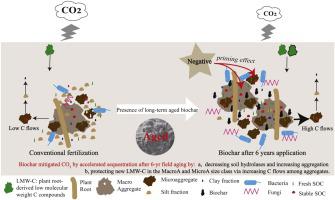Soil and Tillage Research ( IF 6.5 ) Pub Date : 2021-02-08 , DOI: 10.1016/j.still.2021.104955 Qianqian Zhang , Pengpeng Duan , Anna Gunina , Xi Zhang , Xiaoyuan Yan , Yakov Kuzyakov , Zhengqin Xiong

|
Understanding the process of carbon (C) sequestration under biochar amendment is crucial to mitigate climate change. However, the actual annual C sequestration rates after biochar application and underlying mechanisms at a scale of soil aggregates remain unclear. Thus, the C sequestration rates based on a net ecosystem C budget approach were investigated during a consecutive 6 years paddy field (2012–2018). Further, soil samples were collected in 2018 to identify the effects of long-term biochar (20 or 40 t ha−1 applied in 2012) amendment on 1) C sequestration by determining C hydrolyzing activities and mineralization in aggregate size classes and 2) C sequestration between aggregates using the 13C natural abundance. The results showed that biochar-induced annual C sequestration rate decreased during the first two years, whereas it increased during the following four years. The lower ecosystem respiration (-4%) and higher crop yield (+9%) explained the latter C sequestration, compared to N treatment. Relative to N treatment, six years aged biochar decreased soil total organic C (TOC) mineralization in the bulk soil (-12 %), macroaggregate (MacroA, 250−2000 μm, -38 %) and microaggregate (MicroA, 53−250 μm, -19 %) size classes, but increased in silt (2−53 μm, +5%) and clay (0.1−2 μm, +24 %) size classes. Partial least squares path modeling revealed that the decrease in activities of β-glucosidase (-13 %), α-glucosidase (-20 %), cellobiohydrolase (-17 %) and xylanase (-2.5 %) and the improvement in soil structure increased C accumulation. The 13C natural abundance showed that Δ13C (δ13C of aggregates – δ13C of bulk soil) decreased by increasing aggregate size. Biochar increased probability of C flow from MacroA to MicroA, relative to without biochar amended treatment. Thus, biochar protected low molecular weight C compounds in the MacroA, with subsequent fast transfer into MicroA, which having long storage and the highest stable C content among the aggregate size classes. Consequently, increase in C protection via transferring C from MacroA to MicroA and decrease in soil hydrolases activities induced by biochar in MacroA and MicroA contribute to the high C sequestration potential.
中文翻译:

通过长期螯合改良的稻田土壤中的加速固存来减少二氧化碳
了解生物炭修正过程中的碳固存过程对于缓解气候变化至关重要。但是,尚不清楚在施用生物炭后的实际年固碳率和潜在的机制。因此,在连续6年的稻田(2012-2018年)中,研究了基于净生态系统碳预算方法的碳固存率。此外,在2018年收集了土壤样品,以确定长期生物炭(2012年使用20或40 t ha -1)修正案对1)固碳的影响,方法是确定骨料尺寸类别中的C水解活性和矿化作用,以及2)C使用13的集合体之间的隔离C自然丰度。结果表明,生物炭引起的年固碳率在头两年下降,而在随后的四年中上升。与氮处理相比,较低的生态系统呼吸(-4%)和较高的农作物产量(+ 9%)解释了后者的碳固存。相对于氮处理,六年生物炭使散装土壤中土壤总有机碳(TOC)矿化减少(-12%),大型骨料(MacroA,250-2000μm,-38%)和微骨料(MicroA,53-250μm (-19%)大小等级,但淤泥(2-53μm,+ 5%)和黏土(0.1-2μm,+ 24%)大小等级有所增加。偏最小二乘路径模型表明,β-葡萄糖苷酶(-13%),α-葡萄糖苷酶(-20%),纤维二糖水解酶(-17%)和木聚糖酶(-2.5%)的活性下降以及土壤结构的改善均增加C积累。的13 Ç天然丰度表明,Δ 13 C(δ 13集料的Ç - δ 13土体的C)降低,通过增加的聚集体尺寸。相对于未经生物炭改良的处理,生物炭增加了从MacroA到MicroA的C流动的可能性。因此,MacroA中的生物炭保护了低分子量的C化合物,随后又迅速转移到MicroA中,该化合物具有较长的存储时间,并且在总尺寸类别中具有最高的稳定C含量。因此,通过将C从MacroA转移到MicroA来增加C保护作用,并降低由MacroA和MicroA中的生物炭引起的土壤水解酶活性,这有助于高C螯合潜力。

























 京公网安备 11010802027423号
京公网安备 11010802027423号